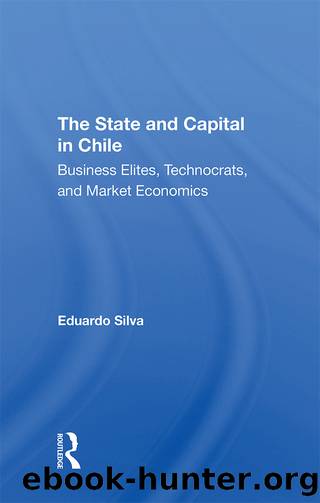The State and Capital in Chile: Business Elites, Technocrats, and Market Economics by Eduardo Silva

Author:Eduardo Silva [Silva, Eduardo]
Language: eng
Format: epub
Tags: Political Science, General
ISBN: 9781000306033
Google: 6AaiDwAAQBAJ
Goodreads: 257080
Publisher: Routledge
Published: 1998-07-23T00:00:00+00:00
6
Triumph and Collapse of Radical Neoliberalism
To a much larger extent than in either Argentina or Uruguay, an economic boom between 1979 and 1981 created a sense of euphoria in Chile, a traditionally poor, austere nation. The traumas, suffering, and sacrifices of the last eight years added to historical feelings of pent up demand among the citizenry. Thus, during this short-lived period of plenty many Chileans reveled in a luxury that had long been denied to them: consumerism. Imported cheeses, consumer durables, and foreign travel, once difficult to obtain, were suddenly available. Scotch whisky, formerly almost impossible to find, became a symbol of the new consumerism. Meanwhile, the media bombarded the population with messages and images lionizing and romanticizing rugged individualism, entrepreneurship, and the benefits of the unfettered marketplace. The Chilean upper and middle classes consoled themselves over their nation's isolation from the international community for human rights abuses with the following belief: Chile had vanquished Marxism and was in the forefront of capitalist development in the developing world.
In Chile, economic success seemed to have vindicated the radical neoliberal model and the means of its implementation. The supporters of radical neoliberalism took advantage of these sentiments to deepen and extend the model. They fixed the exchange rate, let the level of international reserves control of the money supply (automatic adjustment), liberalized capital accounts, and slashed all tariffs to 10 percent, an unusually low rate for Latin America at the time. The government also extended neoliberal principles to social and educational policy.
The neoliberal model, however, began to come under stress in 1981 in Chile as well as Argentina and Uruguay. Like most other Latin American nations, Chile had contracted a large foreign debt in the 1970s and early 1980s. Debt obligations eventually strained the financial system to the breaking point. In 1982, the international debt crisis precipitated the collapse of the Chilean financial system. The economy, the most open in the region, contracted more violently than those of either Argentina or Uruguay GDP plunged 14 percent and unemployment soared to over 25 percent, initially, however, the regime granted few policy concessions to mounting criticism. Significant policy change did not occur until the middle of 1983.
This chapter examines how the expansion and contraction of international liquidity contributed to the extension and demise of the radical neoliberal coalition. The first section argues that between 1978 and 1981, high levels of international liquidity were responsible for the enlargement of the power bloc that backed deepening radical neoliberalism. It drew in other business and landowning groups (and even middle-class groups) to support it. The flood of foreign savings fed the economic boom and sustained social groups excluded from the policy process. Easy credit allowed producers for domestic markets to cope with the negative effects of very low tariffs. They borrowed to expand, diversify or survive in an atmosphere of prosperity. The middle class, as never before, borrowed cheap dollars and consumed goods and services, many of them imported, that had been the preserve of the upper classes.
Download
This site does not store any files on its server. We only index and link to content provided by other sites. Please contact the content providers to delete copyright contents if any and email us, we'll remove relevant links or contents immediately.
Cat's cradle by Kurt Vonnegut(15189)
Pimp by Iceberg Slim(14397)
4 3 2 1: A Novel by Paul Auster(12289)
Underground: A Human History of the Worlds Beneath Our Feet by Will Hunt(12026)
The Radium Girls by Kate Moore(11927)
Wiseguy by Nicholas Pileggi(5674)
Perfect Rhythm by Jae(5326)
American History Stories, Volume III (Yesterday's Classics) by Pratt Mara L(5257)
The Fire Next Time by James Baldwin(5250)
Paper Towns by Green John(5092)
Pale Blue Dot by Carl Sagan(4913)
A Higher Loyalty: Truth, Lies, and Leadership by James Comey(4846)
The Mayflower and the Pilgrims' New World by Nathaniel Philbrick(4428)
The Doomsday Machine by Daniel Ellsberg(4419)
Killers of the Flower Moon: The Osage Murders and the Birth of the FBI by David Grann(4387)
The Sympathizer by Viet Thanh Nguyen(4307)
Too Much and Not the Mood by Durga Chew-Bose(4276)
The Borden Murders by Sarah Miller(4248)
Sticky Fingers by Joe Hagan(4103)
